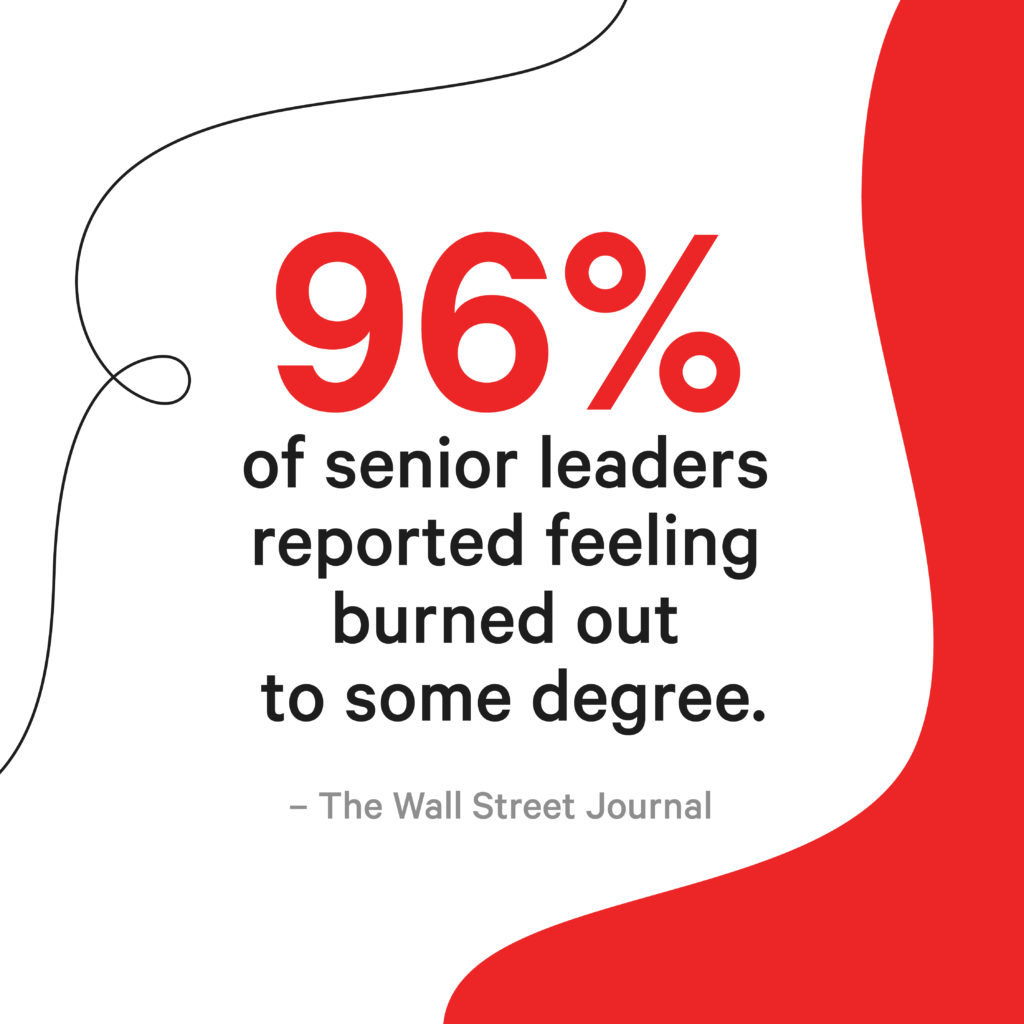Nearly 96 percent of senior leaders reported feeling burned out to some degree, with one-third describing their burnout as extreme, reported The Wall Street Journal.

Stress seems to come with the territory for C-suite executives. They’re accountable to several groups of people on an ongoing basis, including employees, clients, boards of directors, and stakeholders. They’re also more accessible than ever — thanks to technology — which can make it difficult to turn the work world “off” when they leave the office.
Interestingly, although they’re more connected technologically, leaders often feel less connected socially. Executives have fewer peers to confide in, which tends to make them feel emotionally isolated.
Work-life imbalance and a lack of social support are two factors that can cause job burnout, according to the Mayo Clinic. If ignored or unaddressed, job burnout can lead to sadness, anger or irritability, heart disease, high blood pressure, or Type 2 diabetes.
We’re starting to see leading executives make mental health a priority in the workplace.
In order for organizational leaders to truly create a culture that supports mental health, they must first take care of their own.
It’s the same concept as an oxygen mask on an airplane. You have to put on your own oxygen mask before you can assist others.
Here are a few ways to prevent executive burnout and boost executive mental health.
Suggest that your executives have a mental health advocate in their corner.
Great managers check in with employees to see how they’re doing. But who checks in on their boss to tell them they’ve been working too hard or suggest they take the day off? More than likely, the answer is no one.
It’s often up to the leader to recognize the signs of burnout in themselves — and that’s sometimes hard to do.
People who are really invested in their work are often more susceptible to burnout because work is such an integral part of their personal identity, the Society for Human Resource Management reported.
For that reason, executives might need a third-party, mental health advocate to provide a listening ear, help them set boundaries at work or hold them accountable for making time for mental and physical restoration.
This guidance might come from an executive coach, who serves as an objective, third-party advisor. Therapy has also worked wonders for many executives. The idea is just that they have someone to talk to on a regular basis — before the signs of executive burnout present themselves.
Time is often a barrier for many leaders who could benefit from coaching or therapy services. However, by making the up-front time investment, they’ll find they have fuller cups to pour back into their work and personal lives.
Explain the business benefits of taking care of their mental health — and the consequences if they don’t.
When the CEO isn’t taking care of their well-being, it has a trickle-down effect.
Let’s use sleep, as an example, which impacts both our mental and physical health.
On average, CEOs slept 6.9 hours a night, according to one study by two Harvard professors who tracked how 27 CEOs of companies with an average annual revenue of $13.1 billion spent their days. That amount of sleep is below the 7 to 9 hours of sleep recommended for adults (age 26 to 64 years old) by the Cleveland Clinic.
Although CEOs aren’t sleeping the recommended amount, they’re still putting in long hours the next day. CEOs work more than the average American (62.5 hours per week compared to 44 hours per week).
When you don’t get enough sleep, the short-term effects — according to the Cleveland Clinic — can include:
- Lack of awareness
- Impaired memory
- Interpersonal conflict
- Worsened quality of life
Chronic sleep deprivation can also lead to high blood pressure, diabetes, heart attack, heart failure and stroke (Cleveland Clinic). It’s even been linked to depression.
Conversely, your executive’s mental health regime can also positively impact your workforce. When executives prioritize their own mental and physical health, it encourages others to do the same, creating a culture of mental and physical well-being.
When leaders “walk the walk,” they’re also helping to reinforce the messages from their company’s well-being programs and initiatives. That’s especially important given the fact that nearly half of U.S. worksites offer some type of health program to employees, according to the Centers for Disease Control and Prevention.
Engagement and well-being are also key to employee performance, based on Gallup research.
When it comes to mental health in the workplace – the need is critical and urgent.
Discover Aduro’s Integrated Employee Mental Health Solution.
Encourage leaders to join peer groups.
One way to help leaders feel less socially isolated? Connect them with other like-minded individuals. CEO peer groups, for example, are made up of executives who typically run similar-sized companies with similar challenges.
These groups are a safe place for executives to talk about problems they’re facing that they may not be sure how to address. Executives often feel like they have to have all the answers at work, which can sometimes stifle their growth. Meeting with peers outside of their own company allows them to openly ask questions, grow beyond their current knowledge, and work on the business instead of in it.
Additionally, peer groups provide executives with emotional support when they’re going through a tough situation. That’s important because executives typically try to carry the company’s problems on their own shoulders, in order to shield their employees from facing them.
These groups give executives an outlet to share their struggles — and even talk through potential solutions with people who have already overcome the same challenges.
Empower executives to take down-time to disconnect.
How many times have you heard your executives say, “I can’t take a day off; there’s too much going on.”?
But if Reed Hastings, Netflix’s CEO, can do it, so can you. He takes six weeks of vacation every year, according to CNN. Hastings actually makes a point to talk about it openly, in order to set an example for other employees about the importance of taking time off.
Taking a break doesn’t always have to mean taking a vacation though. Boost executive mental health by using “wait” time to unwind, not work. Business trip flights could be used to read a new book, listen to a podcast or watch a movie.
Breaks give our minds time to rest — and the ability to return to work rejuvenated.

